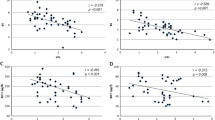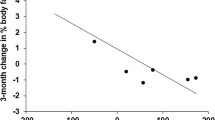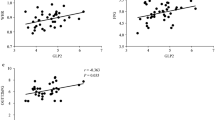Abstract
OBJECTIVE: To compare insulin-like growth factor-I (IGF-I) concentrations in obese and normal subjects, and evaluate the possible relationships between IGF-I concentrations and demographic, anthropometric, metabolic and hormonal variables in obese patients.
SUBJECTS AND METHODS: 286 obese outpatients (OB, 234 female and 52 male; age 18–71 y, body mass index (BMI) >27 kg/m2) were recruited.
MEASUREMENTS: BMI, waist-to-hip ratio (WHR), serum basal and oral glucose tolerance test (OGTT)-stimulated glucose and insulin concentrations, IGF-I, basal growth hormone (GH), prolactin (PRL), androgens, thyrotropin (TSH), free triiodothyronine (fT3), free thyroxine (fT4), free fatty acids (FFA), triglycerides, total and high density lipoprotein (HDL)-cholesterol, 24h-urinary cortisol levels and blood pressure (BP) values were measured. IGF-I concentrations were also evaluated in a large population of 326 age-matched controls (controls, 228 women, 98 men; age 20–86 y, BMI <25 kg/m2).
RESULTS: IGF-I concentrations were lower in OB than in controls (age-adjusted mean: 21.6 vs 23.6 nmol/L, P<0.03). However, individual IGF-I concentrations in OB were within the age-adjusted normal range. In both groups, IGF-I concentrations were gender-independent, and showed a simple negative correlation with age (r=−0.47). In OB, univariate analysis also shows that IGF-I concentrations were negatively correlated with BMI (r=−0.33), but not WHR, with both basal (r=−0.16) and OGTT-stimulated glucose levels (r=−0.17), as well as FFA levels (r=−0.19), and with both diastolic and systolic BP (both r=−0.17). In OB women, IGF-I concentrations positively correlated with PRL (r=0.31), testosterone (r=0.30), androstenedione (r=0.30), and dehydroepiandrosterone-sulfate (DHEAS) concentrations (r=0.41). No correlation was found with other variables. The multiple regression analysis showed that IGF-I concentrations were inversely and independently related to age and BMI only.
CONCLUSIONS: In obesity, IGF-I concentrations are slightly reduced, but generally within the age-adjusted normal range. IGF-I concentrations in obesity show independent and negative relationships with age and BMI, but are not associated with fat distribution, insulin secretion, glucose tolerance, BP or risk indices for cardiovascular disease (CVD).
Similar content being viewed by others
Author information
Authors and Affiliations
Corresponding author
Rights and permissions
About this article
Cite this article
Maccario, M., Ramunni, J., Oleandri, S. et al. Relationships between IGF-I and age, gender, body mass, fat distribution, metabolic and hormonal variables in obese patients. Int J Obes 23, 612–618 (1999). https://doi.org/10.1038/sj.ijo.0800889
Received:
Revised:
Accepted:
Published:
Issue Date:
DOI: https://doi.org/10.1038/sj.ijo.0800889
- Springer Nature Limited
Keywords
This article is cited by
-
The Association Between IGF-1 Levels and the Histologic Severity of Nonalcoholic Fatty Liver Disease
Clinical and Translational Gastroenterology (2017)
-
Epidemiologic survey: reference ranges of serum insulin-like growth factor 1 levels in Caucasian adult population with immunoradiometric assay
Endocrine (2011)
-
Tissue‐Specificity and Ethnic Diversity in Obesity‐Related Risk of Cancer May Be Explained by Variability in Insulin Response and Insulin Signaling Pathways
Obesity (2010)
-
Growth hormone/insulin-like growth factor-I axis in obstructive sleep apnea syndrome: An update
Journal of Endocrinological Investigation (2010)
-
Relationship Between Growth Hormone/Insulin-Like Growth Factor-1 Axis Integrity and Voluntary Weight Loss After Gastric Banding Surgery for Severe Obesity
Obesity Surgery (2010)




